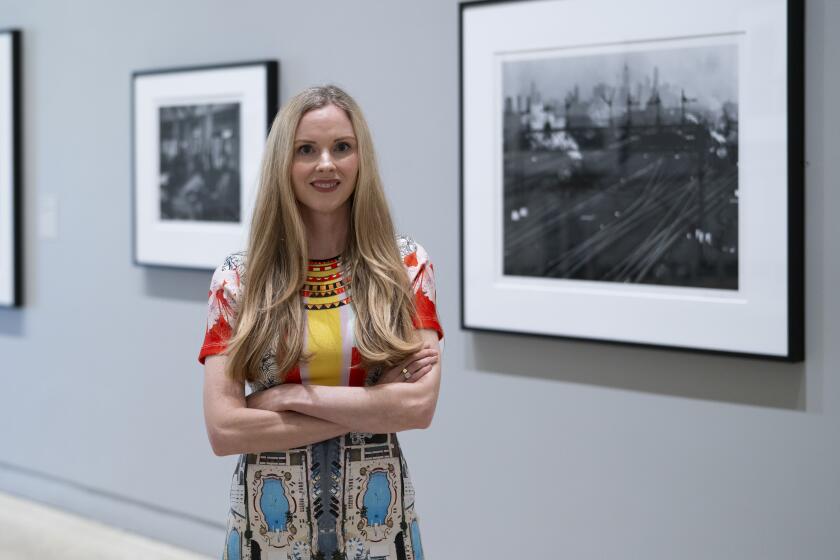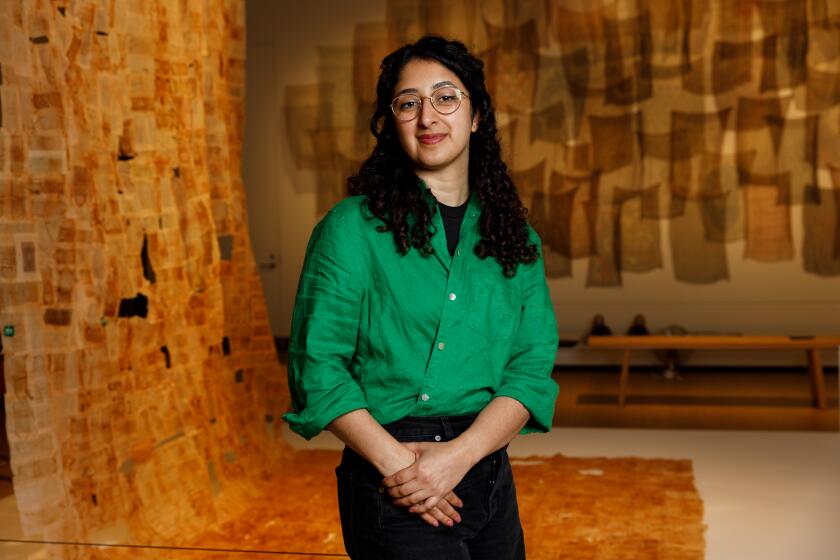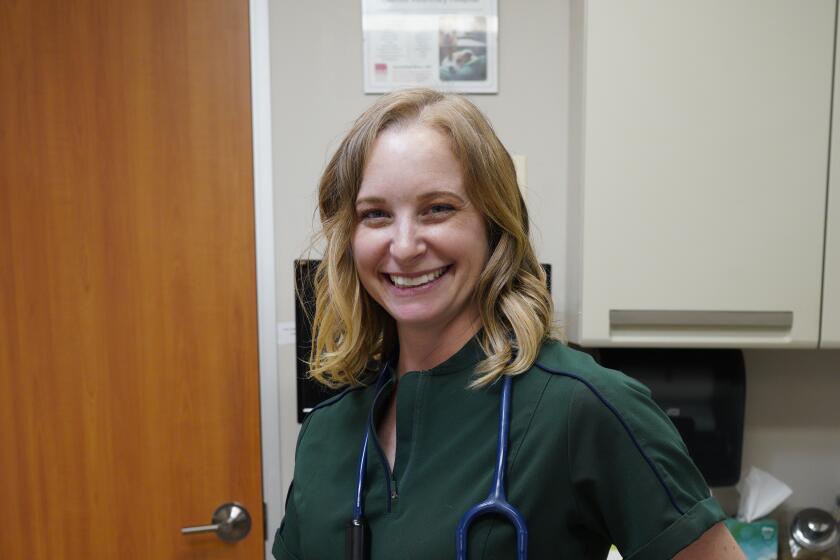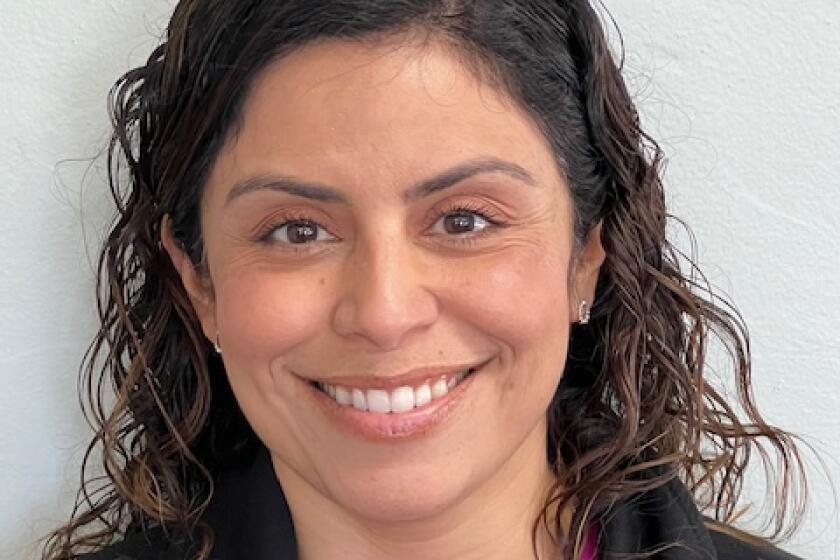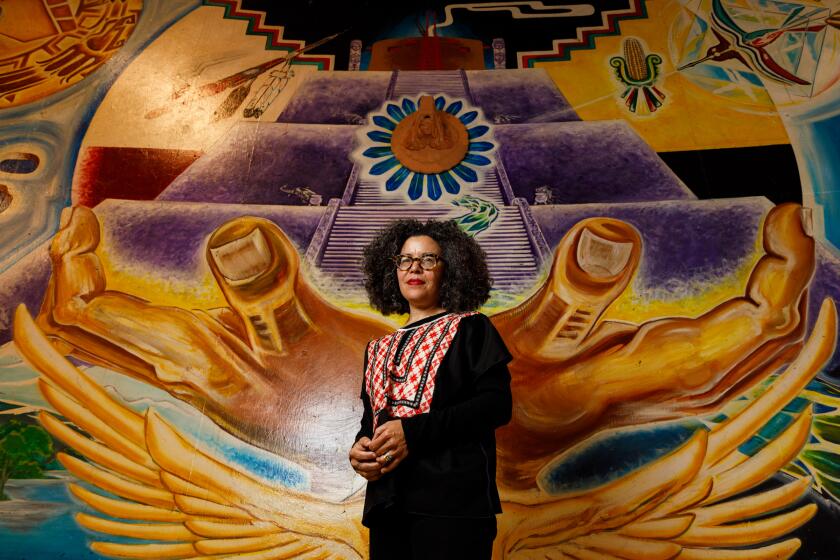La Mesa artist creates Dia de los Muertos altar to honor Chicana artist Yolanda Lopez at fall festival

Katie Ruiz created a commissioned ofrenda dedicated to legendary artist in celebration of Dia de los Muertos at the San Diego Botanic Garden on Oct. 23 and 31
Every year, artist Katie Ruiz creates an ofrenda (altar) at home in honor of Dia de los Muertos, the Mexican holiday to honor deceased loved ones. This year she was commissioned to create one and chose to dedicate it to an artist she holds a deep respect and admiration for—the late Yolanda Lopez, who created decades of work both radical and widely celebrated.
“I chose Yolanda Lopez because I felt it was an opportunity to highlight a Chicana artist and create a learning experience for North County folks who may not have learned about her groundbreaking work,” she says. “It gives me an opportunity to talk about her and then people can go see her work at the Museum of Contemporary Art, San Diego, so it seemed like the perfect time.” (Lopez’s work is on display in the first solo exhibition of her pieces, “Yolanda Lopez: Portrait of the Artist,” and features dozens of works she created between 1975 and 1988, most while attending UC San Diego.)
For the record:
6:25 p.m. Oct. 25, 2021An earlier version of this story included incorrect information about the dates of the San Diego Botanic Garden’s Fall Festival. While the Dia de los Muertos ofrenda dedicated to the late Yolanda Lopez will be on display again on Oct. 31, the festival itself continues every day that the garden is open, through mid-November.
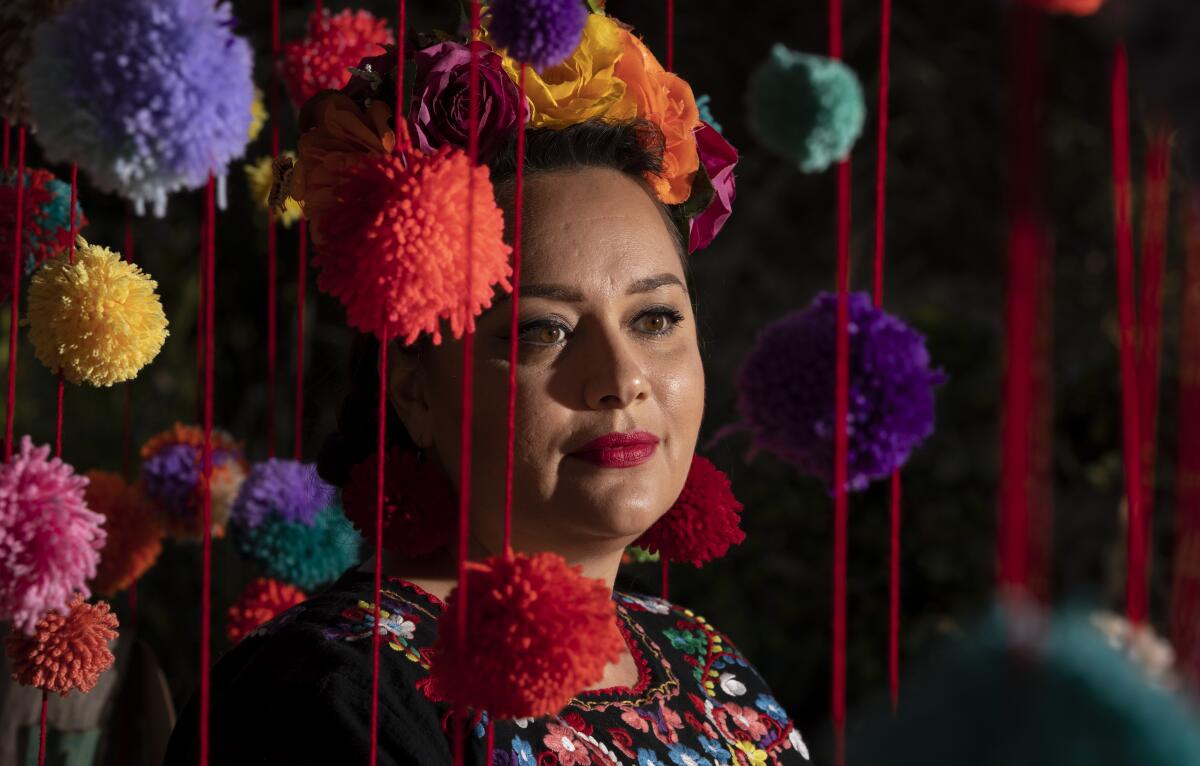
Ruiz’s ofrenda honoring Lopez is a community effort with about 100 collaborating volunteers and will be on display at the San Diego Botanic Garden’s Fall Festival, from 10 a.m. to 4 p.m. today and Oct. 31 (the overall festival continues at the Encinitas garden through mid-November) . Ruiz, 37, is an artist who does a lot of work with figure painting and sculpture, incorporating elements and objects from nature into her work. She lives in La Mesa and took some time to talk about this ofrenda dedicated to Lopez, the impact of Lopez’s work on her own art, and the significance of the Dia de los Muertos holiday in her life.
Q: Tell us about the ofrenda.
A: I had about six months to think of some ideas before we got started. I took pictures of the garden spaces and drew my ideas out on an iPad. Then, we held pompom parties at various locations where groups of people came together to create pompoms as a community (small, brightly colored balls typically made from yarn).
This altar has a round, 60-inch base that you can walk around, and it stands over 10 feet tall. The garden volunteers built a wooden shelf structure, which tapers up to an arch with oil painted portraits I created of the late Yolanda Lopez, in her signature (Virgin of) Guadalupe poses. Volunteers from the garden, Poway Girl Scout Troop 2011, and San Diego’s You Belong Here, created over 1,500 pompoms for this event. The pompoms are decorating the altar and its surrounding areas.
I created giant, papier-mâché calaveras (skulls) and fruit, along with giant papel picado (a type of Mexican folk art created by cutting designs into paper) and images of Yolanda and her paintings, incense, water, and a paint palette and brushes, which were the artist’s favorite items. I knew I wanted to make a lot of orange pompoms that mimic the look of the marigolds, another important aspect of the ofrenda. I wanted to use a lot of craft elements, like traditional papier-mâché, because I am interested in craft as fine art, and usually try to use materials that may be considered childlike or less valuable in society’s eyes, and then flip it on its head until you cannot deny its place in the fine art world.
It’s taken two months of all of these people making objects, and a few months of conversation and design before that. It was a fun experience that brought people together.
Q: What kind of influence have Yolanda Lopez’s life and work had on you?
A: When I first heard of Yolanda Lopez and her work, I had moved back to San Diego after my scholarship to graduate school at the New York Studio School of Drawing, Painting and Sculpture in New York City. I had previously never had any formal education in Chicano art. I was raised in Arizona during the time when Chicano studies were banned, and I hadn’t learned much of anything about my own culture. As I navigated my world with a Caucasian mother and a Mexican father, as a Chicana artist living at the border, I began to see Chicano as its own culture. Lopez’s work is so brave and so bold. Her work, and that of others like Judy Baca and Laura Aguilar, have opened a new world to me, and my voice in the art world.
Q: What was the first piece of hers that you recall seeing? What was your initial reaction to that piece, and why?
A: My first reaction was, “Whoa.” I had made paintings similar to hers with a Guadalupe figure replaced by other figures. However, I was too afraid to really show the work of art for fear of backlash. So, when I saw her work, I thought of how brave it was, what she was doing, and how afraid she must have been to show the work based on the implications the paintings make. Those implications being that all women are holy, that Latinas are holy, working women and aging women are all illuminated.
What I love about La Mesa...
I have lived all over this county, from Oceanside to Carlsbad, Little Italy to Sherman Heights, and now La Mesa. What I love about La Mesa is the amazing amount of bird sounds. I also love the downtown area and my favorite new coffee shop, Pink Rose Cafe.
Q: What are some of your favorite pieces of hers?
A: Well, its hard to choose because I love the narration of the photograph series of her self-portrait as Guadalupe. I love how absolutely herself she is in all of the work — she is a runner, a Latina raised in Barrio Logan. I love the marks, the drawing quality of the large, charcoal drawings of women, drawn larger than life and towering over the viewer. I appreciate her diversity in working within many media, from painting and drawing to collage and photography. Overall, though, I love the message through her work.
Q: What kind of significance does the celebration of Dia de los Muertos hold for you, personally?
A: In 2004, I lived Guanajuato, Mexico, for a year. At the time, I was mourning the death of my first love, Brian, who died tragically in a canoe accident. I attended the celebrations and gained a new love for the holiday, as it is a way to reconnect with your loved one. I found the process cathartic and began to build an altar every year for Brian.
Q: How do you and/or your family typically celebrate this holiday?
A: I love to dress up and visit all of the beautiful altars and celebrations around the city. There are amazing altars that go up in Chicano Park, at the Sherman Heights Community Center, and many more places. The creation of the altar has always been a solo act for me, a ritual of gathering and placing items and finding the person’s pictures, listening to music and adding all of the little details to make the ofrenda. I have always been attracted to the bright colors of Mexican textiles and decorative papel picado and paper flowers, which have influenced a lot of my work.
Q: What do you hope people see/understand when they visit your ofrenda at the botanic garden on Saturday?
A: I hope people learn about Yolanda, if they didn’t know about her already, and I hope that they take away inspiration to make an altar at home, or learn about more about the holiday. Or, maybe they will get inspired to make pompoms and papier-mâché, or gain a new appreciation for the work.
Q: What’s been challenging about your work?
A: I’d say it’s challenging just to be an artist, its more challenging when you are a woman or a BIPOC (Black, Indigenous, People Of Color) person. Chicano art has been ignored by the greater art world for a long time and it is just recently, and because of women like Yolanda, that the art world is opening up to other narratives and perspectives.
Q: What’s been rewarding about this work?
A: I feel so fulfilled when people help with the project and then get to see the final result and feel that they were part of this artwork. I can’t tell you how many people say they needed that in their life, that they needed craft time, especially the adults!
Q: What has this work taught you about yourself?
A: It’s taught me that I don’t have to do everything myself, and that I shouldn’t even try to. That trying to do everything myself limits me. I am kind of a loner and painting is one of those things you mostly do alone, but these larger installations are about the community engagement, they are about inspiring people to add beauty in the world, to engage in art, and connect.
Q: What is the best advice you’ve ever received?
A: Small wins. You don’t become a famous artist, you have little win after a little win and it’s a long game.
Q: What is one thing people would be surprised to find out about you?
A: I travelled around the world on Semester at Sea when I was 18 years old. That inspired me to live in Africa and work in a refugee camp, where I did a yarn project, a knitting group, art class, and mural project in Dukwi refugee camp in Botswana. I’ve also been to 22 countries.
Q: Describe your ideal San Diego weekend.
A: I love when there are some great art openings around town to see, and some fun festivities at Chicano Park. I enjoy taking my dog to Coronado’s dog park, maybe try out a new restaurant, and visit with friends and family.
Get Essential San Diego, weekday mornings
Get top headlines from the Union-Tribune in your inbox weekday mornings, including top news, local, sports, business, entertainment and opinion.
You may occasionally receive promotional content from the San Diego Union-Tribune.

